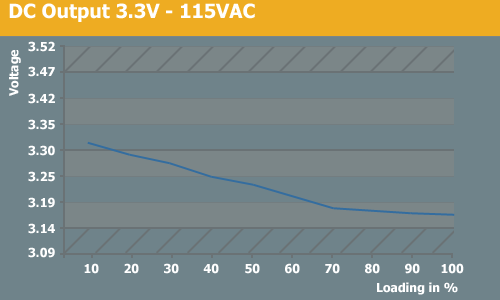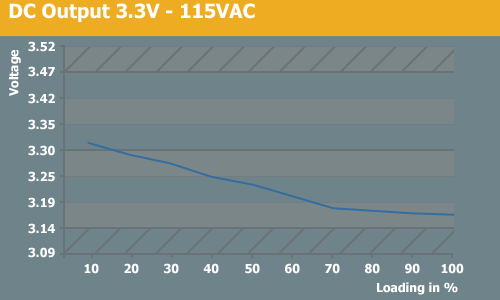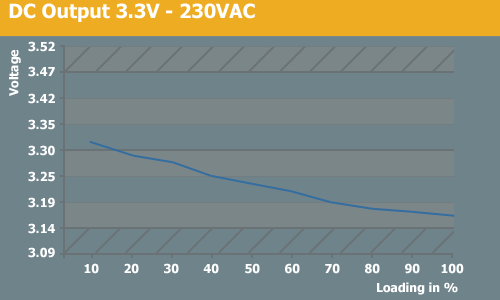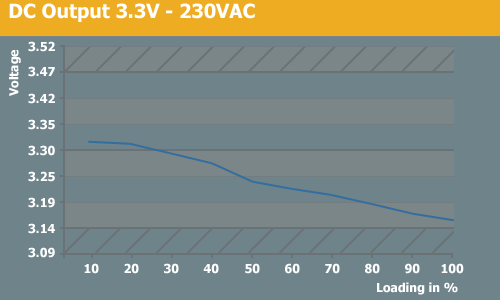Gigabyte's New Odin GT 800W Power Supply
by Christoph Katzer on July 24, 2007 12:01 AM EST- Posted in
- Cases/Cooling/PSUs
3.3V DC Output
Starting with the 3.3V rails we encounter slight problems. At lower loads there's nothing to concern us, but as the load rises the 3.3V rail drops tremendously and barely manages to stay within specification. As we will describe later on we have measured the same low voltages with the P-Tuner software which confirms our readings, and we will see this pattern on all of the other rails. It's not only at higher temperatures that this power supply delivers lower voltages; we found even at room temperature where the internal components should stay cooler that we still get large voltage drops.
The heatsinks don't get too hot like as we will see later, but since we only measure the heatsinks we don't know the exact temperatures of the other components on the PCB. As we mentioned earlier, we think that the heatsinks may be too big to let any air through to the components on the board. The dropping voltages could be a result of this.




| 3.3V DC Output | |||
| Percentage | Amperage | Wattage | Wattage (All rails combined) |
| 10% | 1.92 | 6.36 | 77.95 |
| 20% | 3.85 | 12.67 | 158.11 |
| 30% | 5.77 | 18.87 | 236.48 |
| 40% | 7.7 | 25.03 | 314.35 |
| 50% | 9.62 | 31.07 | 391.55 |
| 60% | 11.55 | 37.08 | 467.94 |
| 70% | 13.47 | 42.97 | 544.95 |
| 80% | 15.4 | 48.82 | 620.44 |
| 90% | 17.32 | 54.39 | 695.26 |
| 100% | 19.25 | 60.06 | 769.57 |
Starting with the 3.3V rails we encounter slight problems. At lower loads there's nothing to concern us, but as the load rises the 3.3V rail drops tremendously and barely manages to stay within specification. As we will describe later on we have measured the same low voltages with the P-Tuner software which confirms our readings, and we will see this pattern on all of the other rails. It's not only at higher temperatures that this power supply delivers lower voltages; we found even at room temperature where the internal components should stay cooler that we still get large voltage drops.
The heatsinks don't get too hot like as we will see later, but since we only measure the heatsinks we don't know the exact temperatures of the other components on the PCB. As we mentioned earlier, we think that the heatsinks may be too big to let any air through to the components on the board. The dropping voltages could be a result of this.














23 Comments
View All Comments
strikeback03 - Tuesday, July 24, 2007 - link
Does the software need to be running for the voltage regulation to work? Or can you make changes then close the software and have the changes still work on the PSU?Also I'd guess if UV lighting is that useful for a case you could swap the blue LEDs for some UV ones - looks like enough wire is exposed to cut the blue ones and solder in UV ones.
Oberst - Tuesday, July 24, 2007 - link
Hello,nice review (i wouldn't expect anything else of you). But I've got a question about the measuring-software: Was it reliable, when measuring voltages? You already mentioned, that the wattage was not reliable. So I'd like to know, if that was because of wrong measured amps or volts.
greets Oberst.
Christoph Katzer - Tuesday, July 24, 2007 - link
Voltages have been quite accurate; amps have been wrong in almost every case.qpwoei - Tuesday, July 24, 2007 - link
Once you've got the ripple measurements sorted out, it'd be nice to get some scope traces as the load changes. Poor transient response of the rails can cause all sorts of hard-to-diagnose problems in the real world.Christoph Katzer - Tuesday, July 24, 2007 - link
We use a scope to follow response on the rails but until now we feel the data is not good enough to present. If there would be something to extraordinary to tell we surely would.bob4432 - Tuesday, July 24, 2007 - link
what about that? a good quality unit, the Corsair 520HX seems to be a lot of people's favorite lately, how does it really stack up? or some of the FSP "Green" units - are they really that efficient? what about seasonic - really as good as everyone says?these reports are all fine and dandy, but you are catering to possibly 5% of your user base, yes even here 800W is extreme overkill.
and it is not a $$$ issue but rather a reality issue. i am surprised you guys testing these are continuing the thought process by only reviewing the upper wattage units and thus making everyone think they need one when they don't - people on review 750W psus, so i must need one...come on guys
Christoph Katzer - Tuesday, July 24, 2007 - link
Will come. No worries about that. At the moment we are just starting as you can see and of course every company wants to have the best PSU tested first. We'll have lower ones very soon but need to work on that mountain of PSUs here first. With 380w you will see a Seasonic pretty soon for example.bob4432 - Tuesday, July 24, 2007 - link
will definitely be looking forward to them :)ATWindsor - Tuesday, July 24, 2007 - link
I disagree that an OCP per rail i s a good thing, it onyl makes using the PSU more of a hassle, since you can draw a lot less from the PSU on 12V than the specs would make possible, if you are unlucky and draw most of it from one rail. Several manufacturers have one big rail without any know safety-problems, having an OCP for the combined drav from the 12V-lines however is a good thing.AtW
dare2savefreedom - Tuesday, July 24, 2007 - link
I would be interested in knowing how a psu runs with dual 8800gtxs in virginia in summertime in an old house with a window air conditioner.Not these theoretical white glove clean room lab environment tests.
triple sli 8800gtx?
come one stop playing with your iphone.